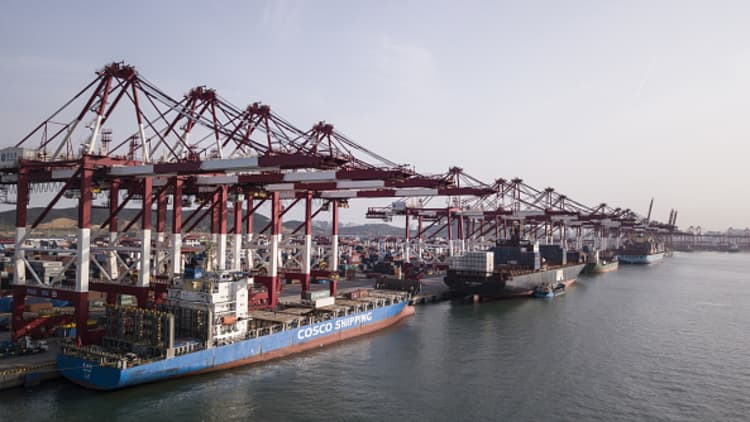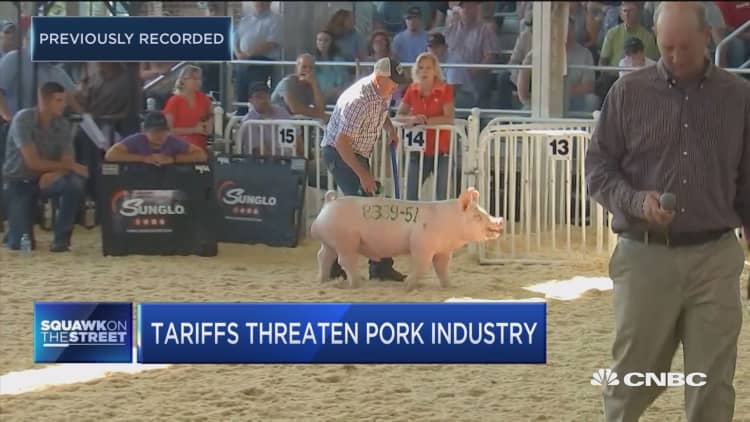
U.S. pork producers are about to be bitten by a second batch of hefty retaliatory tariffs from China and Mexico — and that has some large producers predicting they could lose big money and be forced to invest overseas.
Executives say the pork industry has been expanding in recent years, in part on the expectation of export opportunities that would continue to support growth. However, the threat of a trade war is adding uncertainty and driving fear. One in 4 hogs raised in the U.S. is sold overseas, and the Chinese are the world's top consumers of pork.
"We put a halt on all investment, not just because we will be losing money, but because we don't know if growing in the U.S. is the right move if we won't be an exporting country," said Ken Maschhoff, chairman of Maschhoff Family Foods and co-owner of the nation's largest family-owned pork producer.
Maschhoff said the farm industry has been "asked to be good patriots. We have been. But I don't want to be the patriot who dies at the end of the war. If we go out of business, it's tough to look at my kids and the 550 farm families that look us into the eye and our 1,400 employees."
Mexico imposed a 10 percent tariff on chilled and frozen pork muscle cuts effective June 5, and that import tax is set to double to 20 percent on Thursday. Mexico's retaliatory action followed the Trump administration's duties on imported aluminum and steel.

China, meantime, is scheduled to start collecting an additional 25 percent import duty Friday on American pork products as it targets $34 billion worth of U.S. goods in response to President Donald Trump's action against Beijing for alleged intellectual property theft.
China also is set to add tariffs this week on U.S. soybeans, corn, wheat, cotton, whiskey and dairy, as well as U.S. autos. Nearly $20 billion in U.S. agricultural exports went to China last year, with the more than half of that amount coming from soybeans.
"It's pretty apparent that these countries will go after, by and large, Trump supporters from a political base standpoint since items exported by red states are the ones being targeted," said Maschhoff, a past president of the National Pork Producers Council and a fifth-generation hog producer.
Whopping taxes and 'red ink'
In April, China slapped U.S. pork imports with a 25 percent duty, in retaliation for the Trump administration's steel tariffs. When combined with previous import levies, "the other white meat" will be subjected to import taxes that approach a whopping 71 percent cumulatively, according to Rabobank, a financial services firm for the agribusiness. And that's without including the 10 percent VAT, or value-added tax, that China charges for the import of agricultural products.
Industry analysts say China's high import tax essentially slams the door shut on U.S. pork imports into China, which will also begin collecting 25 percent tariffs for soybeans this Friday.
"At 81 percent net tariff, you're not moving any pork product into China," said Christine McCracken, executive director of animal protein at Rabobank.
"I would suspect by the end of the year, hog producers will be losing quite a bit of money. Part of it is just surplus pork on the market. We've been in an expansion mode."
Industry experts estimate that the Chinese tariffs alone represent around $18 per animal on an annualized basis, or more than $2 billion.
According to Maschhoff, the tariff will result in a hit of $100 million for his Illinois-based family farm operation, which markets about 5.5 million hogs a year and operates in 10 states.
"That's one farm company, and not the whole industry," said Maschhoff. "It's really tough and we had anticipated a decent 2018-19. This is only the second time we've had red ink 37 years in the business."
Even some big U.S.-based food companies such as Hormel Foods and Tyson Foods are exposed to the new tit-for-tat reality between the U.S. and Mexico. Virginia-based Smithfield Foods, the nation's largest pork producer, is owned by China's WH Group, and ships pork to more than 40 countries. The company declined comment to CNBC.
Hormel Foods warned in a 10-Q regulatory filing April 29 that "pork export margins could be challenged near-term due to tariffs on exports to China." But in a statement to CNBC, the company indicated that "only a very small portion of our pork is exported. We will be closely monitoring any impact on the broader protein markets."
Tyson has exposure to Mexico's and China's meat markets. "With the current volatility in trade relations, we’ve experienced day-to-day uncertainty in our ability to deliver products and services to customers," the company said. "With countries imposing retaliatory tariffs on U.S. products, Tyson Foods as well as others in U.S. food and agriculture, will lose our competitive advantage in critical export markets like Mexico, Canada and China."
The impact on the new tariffs is amplified by the domestic pork industry's expansion in recent years and the record-high hog herd disclosed last week by the U.S. Department of Agriculture. Also, the trade tussle with China comes as export volumes to China have been trending down from 2016 levels, when there was record need for imported pork.
"We might have been better able to weather the tariff rate increase (back in 2016) than we can now," said Joe Schuele, a spokesman for the U.S. Meat Export Federation, a trade association. "You've got a lot of suppliers — the European Union, Canada, Brazil, and the U.S. — competing for a tighter space."
He continued, "That makes it an even more difficult situation than if it had come about in 2016 when China had really a record need for imported pork."
China ranked as the second-largest volume market for U.S. hog producers last year, and in export value totaled about $1.1 billion, according to the federation. Mexico was the largest volume market last year, and in export value totaled $1.5 billion, slightly behind Japan.
'We are the casualty'
The Mexican and Chinese markets have been seen as especially important to the U.S. pork producers because they have purchased product that Americans typically don't buy, including raw hams and "variety meats" like tongue, ears, snout and heart.
However, it's no surprise that Mexico has been looking to other global suppliers for pork, such as Brazil, Chile and the European Union. The country has other agricultural product concerns amid the North American Free Trade Agreement renegotiation talks. Andres Manuel Lopez Obrador, the president-elect of Mexico, has been advocating a reduction in dependence on U.S. farm imports.
"Mexico and China are about 40 percent of total exports, so those are critical markets and it's a significant concern with U.S. pork," said Jim Monroe, a spokesman for the National Pork Producers Council, a trade group.
"The longer these trade disputes go on, and the cloud of uncertainty remains over the industry, it's going to have real negative financial consequences for U.S. pork producers," Monroe said. "It's a shame, because we support so many jobs, and when we can compete on a level playing field around the world we do extremely well."
In 2017, the average value of a hog was $147 — and of that amount almost $54 of the total value was driven by exports, according to Monroe. He said about 550,000 jobs are tied to the pork sector and 110,000 of them are directly tied to exports.
David Maloni, executive vice president of analytics for ArrowStream, a Chicago-based food service supply chain technology company, said he believes the tariffs are short term and "more tactical" in nature, useful in the broader context of forcing key countries to negotiate on trade.
"Our advice is don't get too wrapped up in politics, but see it as a major buying opportunity for commodities," he added.
Trump has previously offered to make it up to farmers, and USDA Secretary Sonny Perdue has spoken several times about Trump instructing him to craft a plan to help protect farmers and agricultural businesses.
However, producers like Maschhoff aren't looking for farm subsidies from the federal government. He told CNBC that the current programs are not for pork and beef producers, but focused mostly on dairy and grains.
"We want to compete and be able to sell abroad and make sure our government knocks down trade barriers," he said. "All we've accomplished is getting more trade barriers. We are the casualty and predicted it from day one."
WATCH: Exports an important part of pork industry



